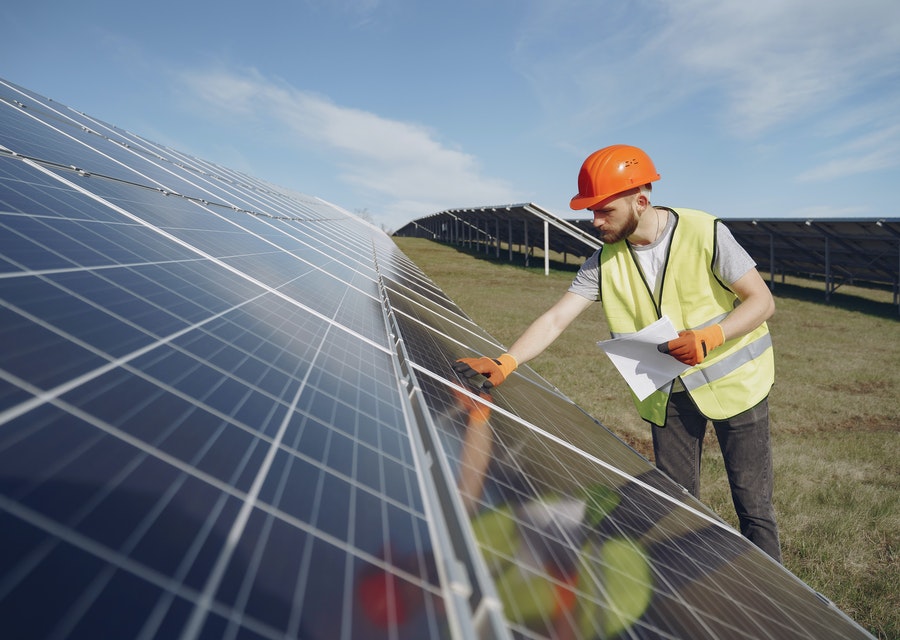Renewable energy is becoming increasingly popular as more people desire to improve the environment and discover sustainable solutions. A common resource for powering homes is solar power. If you’re contemplating making the switch, carefully evaluate your options to guarantee you make the right decision.
Understand the advantages and disadvantages of utilizing solar power in your home. This article will discuss how to use solar panels at home.

What is Solar Power?
Sunlight is a powerful source of energy. Solar power is the process of harnessing and converting the sun’s energy into usable electricity capable of sufficiently powering homes and businesses.
Generating solar energy requires a solar power system. Solar power systems are composed of three primary components including:
- Solar panels: Used to capture the sun’s energy
- An inverter: Responsible for converting the energy into electricity
- Racking: Necessary to mount the entire system
Solar power systems utilize lenses, mirrors, and solar tracking technology to focus sunlight into a small beam and transform it into electricity using photovoltaics.
Understand the basics of solar power and conversion systems to recognize the potential benefits and drawbacks of implementing the technology in your home.
Amazing Benefits of using solar panels at home
Utilizing solar power provides numerous benefits.
A major advantage of solar power is the immense savings. Energy converted through your solar panels is credited to your utility account. Every month the electricity you produced is subtracted from your electric bill, effectively reducing your expenses. Installing solar power is additional home security as it provides electricity backup even the power goes out.
Solar power is also insanely beneficial for the environment. Traditional forms of electricity, specifically fossil fuels, emit carbon dioxide and other harmful gases during production, leading to pollution and global warming. Solar power produces electricity in an environmentally-friendly manner to reduce your carbon footprint and save billions on climate change damages. Lastly, solar power is renewable whereas fossil fuels are finite, meaning the sun’s natural resources will never diminish or ultimately vanish. Solar power offers amazing financial and environmental benefits.
See also: 10 Best Solar Power Banks for camping
Unfortunate Drawbacks
Certain drawbacks are associated with accessing solar power.
A primary disadvantage of using solar power is weather dependence. Time of day, weather forecast, and climate all impact a solar panel’s ability to collect energy, resulting in an average 20% efficiency rate for most solar panels.
Additionally, installation costs for solar panels are incredibly expensive depending on the type and size of the solar power system. Evaluate the unfortunate drawbacks of solar power to ensure the investment is worth it.
Installing Solar Power System at Home
Install a solar power system to supply electricity to your home. Two options are available for installing solar panels: Purchasing a self-installed system or hiring a professional contractor.

A DIY approach is completely possible with basic skills and abilities even if you lack previous experience. The most challenging part is establishing the wired connection, so hire an electrician if you need assistance finishing the job. Installing the system yourself is an excellent way to save money.
Otherwise, discover a local contractor and solar panel expert in your area. Rates will vary depending on the location and size of the job. On average, an installer’s services cost between $3-7,000 for labor.
After you select an installation process, determine the type and amount of solar panels required for your home. Guarantee you purchase the correct system size and the number of solar panels to power your house by calculating the kilowatt-hours of power needed. On average, a homeowner will need 28-34 solar panels to cover their energy usage.
Review the specifics related to installing a solar power system to greatly benefit your home.
Home Evaluation
Perform a home evaluation to ensure your roof is suitable for solar panels.
Questions to consider when inspecting your home include:
- What’s the orientation of the roof? Is there excessive shade?
- What material is the roof made of? Is it durable?
- What is the size, shape, and slope of the roof?
- How old is the roof? Will it need to be replaced soon?
- Are there any obstructions on the roof, such as chimneys, dormers, or vents?
The ideal roof is south-facing and durably constructed with a slope between 15 and 40 degrees. If you need further assistance, discuss the suitability of your roof with a professional contractor.
See also: Comparison: Solar Charger vs. Power Banks
Expected Costs
Generally, a solar power system costs between $10-15,000, which converts to approximately $2.51 to $3.31 per watt.
Recalling the money-saving guarantees of solar panels is important for rationalizing this major investment with a steep price tag. As previously mentioned, you’ll save money monthly on the electric bill and potentially eliminate the expense altogether. In addition, solar panel installation comes with tax incentives, specifically receiving 25-30% of the installation costs back on your federal taxes depending on your location.
Understand the expected costs and financial rewards of installing a solar power system to guarantee you’re aware of the funds involved.
Community Solar Opportunities
Community solar is an excellent alternative to installing solar panels.
It refers to a group of people sharing electricity generated by harnessing solar energy. Other names for community solar include shared solar, energy sharing, and solar farms or gardens.
Shared solar projects are started by third parties, generally, utility companies or private businesses, installing numerous solar panels in a certain area. Energy captured by the solar panels is converted into electricity and delivered to the local power grid. Afterward, the utility company distributes the electricity to various homes and businesses.
As a member of community solar, the energy produced by your share of solar panels is credited to your utility account. The solar credits are subtracted from your electric bill to reveal your new total.
Joining a shared solar project is as simple as locating a nearby solar farm and subscribing to the service.
Proven Advantages
Community solar opportunities provide many advantages. A major benefit is the lack of installation costs. Equipment and maintenance fees are typically covered by the owner, meaning you save thousands of dollars on purchasing solar panels.
Another financial advantage is the guaranteed savings, averaging about a 10% discount monthly.
Lastly, community solar makes solar power more accessible. If you lack the upfront costs, rent your home, or possess unsuitable roof conditions, shared solar is the positive solution. Community solar continues to increase in popularity with projects in 39 states.
Research community solar projects to find no roof solar opportunities near you. Understand solar power to consider implementing it in your home.
Review solar power system installation and community solar opportunities to make the perfect decision for you, your family, and your home.
This is how you can use solar panels at home. Stay tuned for more solar updates.









































